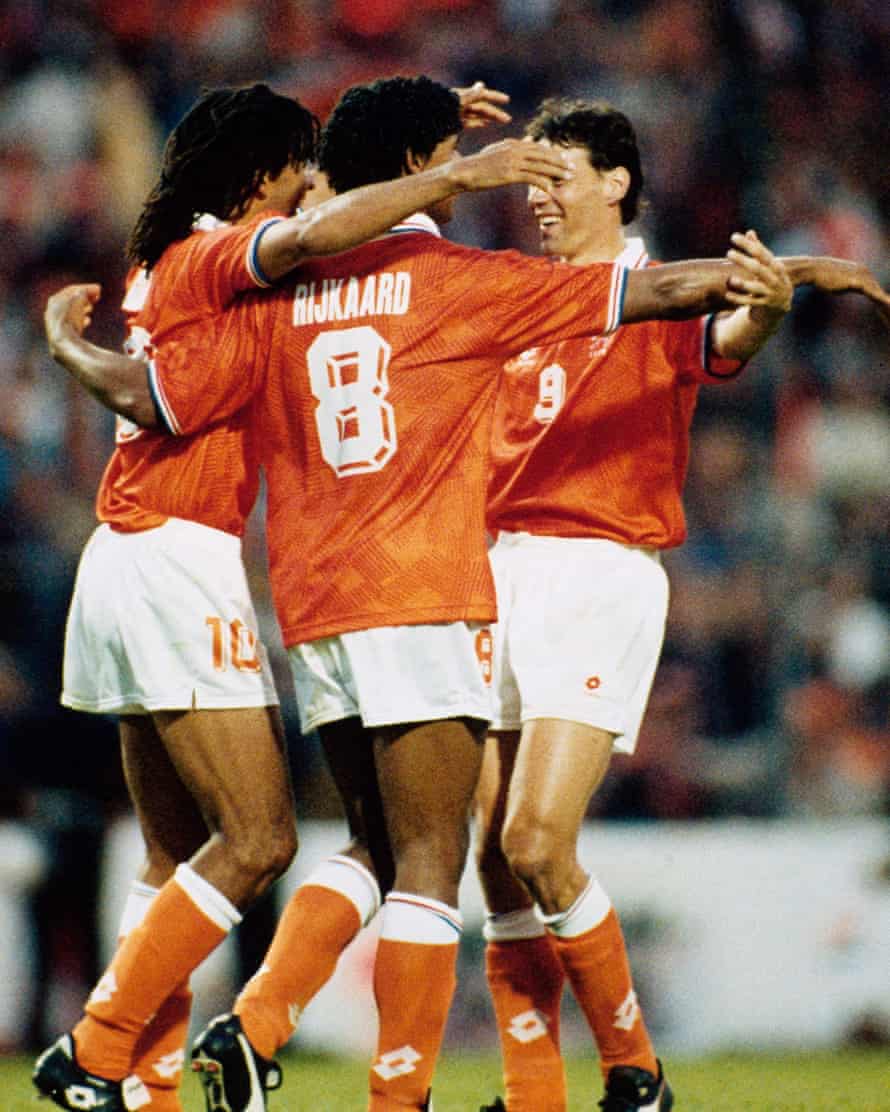Let’s start with a bit of housekeeping. None of these are technically assists; under the current definition, that requires a tactile involvement. But we needed a fairly snappy headline, and The Joy of Six: Helping to Create Goals Without Touching The Ball just wasn’t going to get the job done.
Off-the-ball runs are usually described as clever and unselfish, or synonyms thereof. A better adjective, which admittedly wouldn’t sound as good coming out of your favourite commentator’s mouth, is probably ambiguous. While some off-the-ball runs are made purely to distract or manoeuvre defenders, the majority are an each-way bet, with one eye on receiving the ball and one on creating space for the teammate in possession.
It’s usually possible to spot the difference, though sometimes there’s no need to make a judgment. Marco van Basten’s off-the-ball run against Germany at Euro 92 was so good that it came with instructions for his teammate and evidence of his unselfishness for the millions watching.
The moment Aron Winter rolled Matthias Sammer and sped down the right, Van Basten started doing an architectural drawing in his head. He made a 10-yard run to drag his marker Jürgen Kohler towards the near post, thus creating a huge gap for Dennis Bergkamp to run into. While running Van Basten pointed behind him towards Bergkamp, just in case Winter needed any additional decision-making clarity.
Winter lifted an immaculate pass – don’t call it a cross – on to the head of Bergkamp, who planted a masterful header past Bodo Illgner. At the time it felt like the goal that would put Germany out of Euro 92 at the group stage, a dream for any Dutch player, though Scotland jiggered that. The goal endures nonetheless, as a masterpiece of simplicity in its passing and movement and, most of all, in the creation and manipulation of space. It wasn’t just a classic goal; it was a classic Dutch goal.

It’s more than a little unfair that, when it comes to innovation, Sam Allardyce is mainly remembered for bringing the 568ml glass of white wine into the mainstream. In his golden years at Bolton, he was one of the most forward-thinking managers in England. He was the first to regularly play 4-3-3 in the Premier League; he was also one of the first to build cosmopolitan teams and to find marginal gains through nutrition, fitness, physiotherapy and data analysis.
Even on a micro level, he rarely missed a trick when it came to maximising results. So when Fifa and Ifab issued new guidelines for the interpretation of the offside law in late 2003, introducing alien concepts like ‘phase of play’, ‘active’ and ‘passive’, Allardyce’s brain became extremely active.
The big reveal came early the following year at Leicester. Whenever Bolton won a free-kick in the final third, two players stood on the six-yard line in deliberately offside positions. Their job was to run back towards the pack as soon as the free-kick was taken, to cause confusion during the first phase and then, potentially, get involved in the second phase.
Even Allardyce couldn’t have imagined quite how well it would work. Kevin Nolan, one of the Ifab-baiters, smacked a post after a free-kick led to chaos in the area. A few minutes later, his run away from goal unnerved the Leicester keeper Ian Walker to such an extent that Walker scored a farcical own goal.
Seventeen years later it looks fairly lame, an inexplicable howler, but at the time Bolton’s tactics were groundbreaking. Nolan and Simon Charlton (we think it’s him) were essentially trespassing in Walker’s home, his six-yard area – except now it was legal. No wonder he was discombobulated.
There was a moral panic after the game, and Allardyce himself said Fifa had got it “horribly wrong … There is obviously nothing I can do apart from try to use it to my advantage.” The loophole was soon tightened, so Allardyce moved on to his next trick. Obviously.
Football has a culture of dishonesty, and anyone who says otherwise is a liar. But there are some bits of simulation we all love, especially when they are soundtracked by a bit of syncopated Samba. Surprise and disguise are essential parts of jogo bonito – unexpected toebungs, hitting the deck in the middle of the wall, almost all of Ronaldinho’s best bits –and Brazil is the spiritual home of the most delicious deception in the game: the dummy.
Pelé’s against Uruguay in 1970 is the greatest of all time. But it’s of precisely no use to us here, as he touched the ball afterwards and it didn’t end in a goal anyway. No matter. For artistic impression, and sheer sporting erotica, it’s hard to beat the moment in 1982 when Falcão opened his legs and showed his class. It led to a spectacular goal from Éder, which completed a late comeback victory over the USSR in Brazil’s opening match, and set the tone for a tournament in which they produced the greatest portfolio of goals ever seen.
When Paulo Isidoro rolled a gentle pass towards Falcão, 25 yards from goal, Falcão closed his legs as if he preparing to receive the ball. It was all part of the grift. Falcão had heard Éder behind him, demanding – not asking – that he “leave it!”, so he waited until the last second before lazily opening his legs again. Reports that he had a resting heart rate at the time, and was whistling Happy Go Lucky Me as the ball rolled through his legs, are unconfirmed.
Falcão extended the opening of his legs into a nonchalant 180-degree turn, all part of the same elegant movement, just in time to see Éder flick the ball up and lash a glorious volley past a motionless Rinat Dasayev. The dummy was more than a beautiful but gratuitous embellishment. The replay from behind the goal shows that, had Falcão let the ball run without any disguise, Vladimir Bessonov would have changed the angle of his run in time to block Éder’s shot.
Brazil’s 1982 team were so astoundingly brilliant with the ball that it’s easy to forget how good they could be without it. Their off-the-ball movement, particularly from Falcão, Sócrates and Toninho Cerezo, came from the 21st century, and this dummy is instant serotonin. Even their defenders managed to create goals by virtue of not touching the ball. Alas, they were opposition goals.

A win-at-more-costs-than-you-could-ever-imagine mentality has led Luis Suárez to use just about every body part on the football field: his shoulder, his hand, his teeth. Yet some of his best work, especially at Barcelona, was done without touching a thing. (There’s a tiki-tactile pun in here somewhere, but we can’t make it work so we’ll leave it at that.)
This selfless sprint is a classic example of his unselflish movement off the ball, and he can do a lot more with a dummy than spit it. At Wembley in 2018 he produced two in one game, ingeniously sending Toby Alderweireld and then Davinson Sánchez off to an alternate universe so that Lionel Messi could score twice. Both demonstrated another body part that Suárez uses to deadly effect: his brain.
Before VAR took away the joy of unashamed cheating, there was another genre of assist without touching the ball: the snide foul. It might be creating a gap in the wall or taking an opponent out off the ball (exhibit A, exhibit B). For sheer brazen, dastardly, hilarious wrongdoing, it’s hard to beat Micky Quinn against Manchester United in a pulsating FA Cup tie at St James’ Park in 1990.
Newcastle were 2-1 down when they won a corner on the right wing. As it was launched skyward, the goalkeeper Jim Leighton came to collect it. While the referee was following the ball, Quinn stalked Leighton and then expertly guided him to the turf. It allowed Kevin Scott to head Newcastle’s second equaliser and threaten to put the under-presusre Alex Ferguson’s team out of the Cup.
In the end Manchester United won 3-2, but Quinn’s foul might have changed football history. Poor Leighton’s career collapsed after he was left out of the FA Cup final replay against Crystal Palace. He was blamed for all sorts in his two years as United’s first-choice goalkeeper. Not even the most vituperative critic would say this was his fault.
“Nayim to the left, Samways ahead. And Lineker uses him by not using him – good try, he’s scored!”

Vinny Samways’ off-the-ball run was a beauty, as measured as Gazza’s suit, but it’s included mainly because of the soundtrack. Barry Davies is the greatest sports commentator we’ve ever heard; his stream of consciousness is more lyrical and profound than all our written words. And here, in a crunch moment in the biggest north London derby for 20 years, he came up with a turn of phrase – “uses him by not using him” – that elegantly captures the value of an off-the-ball run.
from Football | The Guardian https://ift.tt/3qsBGrz
via IFTTT

No Comment